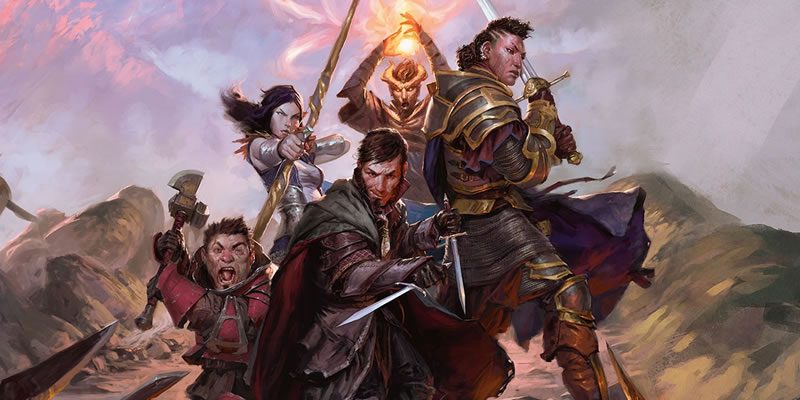
In this month’s Rules Answers from Jeremy Crawford we get rules answers on Great Weapon Fighting, Pact of the Blade, and spells such as Green-Flame Blade, Booming Blade and Moonbeam.
Here is the important stuff from the article…
Class Features
If you use Great Weapon Fighting with a feature like Divine Smite or a spell like hex, do you get to reroll any 1 or 2 you roll for the extra damage?
The Great Weapon Fighting feature (fighters and paladins) is meant to benefit only the damage roll of the weapon used with the feature.
- For example, if you use a greatsword with the feature, you can reroll any 1 or 2 you roll on the weapon’s 2d6.
- If you’re a paladin and use Divine Smite with the greatsword, Great Weapon Fighting doesn’t let you reroll a 1 or 2 that you roll for the damage of Divine Smite.
The main purpose of this limitation is to prevent the tedium of excessive rerolls. Many of the limits in the game are aimed at inhibiting slowdowns. Having no limit would also leave the door open for Great Weapon Fighting to grant more of a damage boost than we intended, although the potential for that is minimal compared to the likelihood that numerous rerolls would bog the game down.
If a warlock uses Pact of the Blade to bond with a magic weapon, does that weapon have to be a melee weapon, and can the warlock change the weapon’s form?
The warlock’s Pact of the Blade feature (PH, 107–8) lets you create a melee weapon out of nothing. Whenever you do so, you determine the weapon’s form, choosing from the melee weapon options in the Weapons table in the Player’s Handbook (p. 149).
- For example, you can create a greataxe, and then use the feature again to create a javelin, which causes the greataxe to disappear.
You can also use Pact of the Blade to bond with a magic weapon, turning it into your pact weapon. This magic weapon doesn’t have to be a melee weapon, so you could use the feature on a +1 longbow, for instance. Once the bond is formed, the magic weapon appears whenever you call your pact weapon to you, and the intent is that you can’t change the magic weapon’s form when it appears.
- For example, if you bond with a flame tongue (longsword) and send the weapon to the feature’s extradimensional space, the weapon comes back as a longsword when you summon it. You don’t get to turn it into a club. Similarly, if you bond with a dagger of venom, you can’t summon it as a maul; it’s always a dagger.
The feature initially allows the conjuring forth of a melee weapon, yet we allow more versatility when it comes to magic weapons. We didn’t want a narrow focus in this feature to make a warlock unhappy when a variety of magic weapons appear in a campaign. Does this versatility extend outside the melee theme of the feature? It sure does, but we’re willing to occasionally bend a design concept if doing so is likely to increase a player’s happiness.
Spells
Can you use green-flame blade and booming blade with Extra Attack, opportunity attacks, Sneak Attack, and other weapon attack options?
- Introduced in the Sword Coast Adventurer’s Guide, the green-flame blade and booming blade spells pose a number of questions, because they each do something unusual: require you to make a melee attack with a weapon as part of the spell’s casting.
- First, each of these spells involves a normal melee weapon attack, not a spell attack, so you use whatever ability modifier you normally use with the weapon. (A spell tells you if it includes a spell attack, and neither of these spells do.) For example, if you use a longsword with green-flame blade, you use your Strength modifier for the weapon’s attack and damage rolls.
- Second, neither green-flame blade nor booming blade works with Extra Attack or any other feature that requires the Attack action. Like other spells, these cantrips require the Cast a Spell action, not the Attack action, and they can’t be used to make an opportunity attack, unless a special feature allows you to do so.
- Third, these weapon attacks work with Sneak Attack if they fulfill the normal requirements for that feature. For example, if you have the Sneak Attack feature and cast green-flame blade with a finesse weapon, you can deal Sneak Attack damage to the target of the weapon attack if you have advantage on the attack roll and hit.
Does moonbeam deal damage when you cast it? What about when its effect moves onto a creature?
The answer to both questions is no. Here’s some elaboration on that answer.
Some spells and other game features create an area of effect that does something when a creature enters that area for the first time on a turn or when a creature starts its turn in that area. The turn you cast such a spell, you’re primarily setting up hurt for your foes on later turns. Moonbeam, for example, creates a beam of light that can damage a creature who enters the beam or who starts its turn in the beam.
Here are some spells with the same timing as moonbeam for their areas of effect:
- blade barrier, cloudkill, cloud of daggers, Evard’s black tentacles, forbiddance, moonbeam, sleet storm, spirit guardians
Reading the description of any of those spells, you might wonder whether a creature is considered to be entering the spell’s area of effect if the area is created on the creature’s space. And if the area of effect can be moved—as the beam of moonbeam can—does moving it into a creature’s space count as the creature entering the area? Our design intent for such spells is this: a creature enters the area of effect when the creature passes into it. Creating the area of effect on the creature or moving it onto the creature doesn’t count. If the creature is still in the area at the start of its turn, it is subjected to the area’s effect.
Entering such an area of effect needn’t be voluntary, unless a spell says otherwise. You can, therefore, hurl a creature into the area with a spell like thunderwave. We consider that clever play, not an imbalance, so hurl away! Keep in mind, however, that a creature is subjected to such an area of effect only the first time it enters the area on a turn. You can’t move a creature in and out of it to damage it over and over again on the same turn.
In summary, a spell like moonbeam affects a creature when the creature passes into the spell’s area of effect and when the creature starts its turn there. You’re essentially creating a hazard on the battlefield.
Let us know what you think of the rulings below in the comments.



